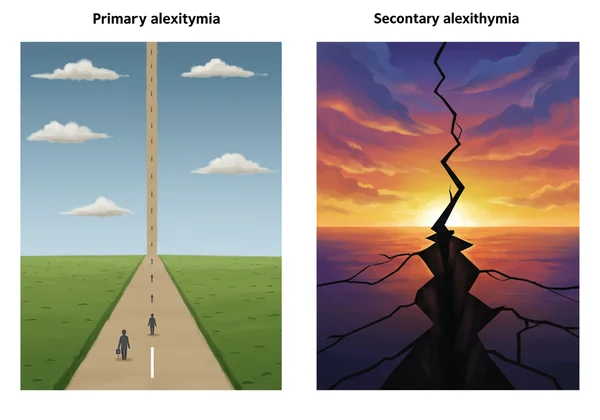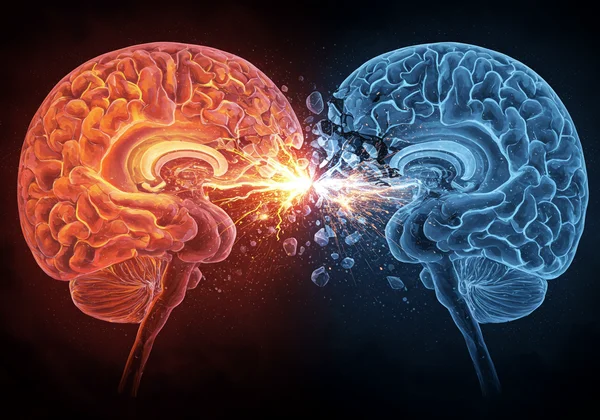Is Alexithymia a Trauma Response? Link to PTSD & Emotional Numbness
Have you ever felt a profound disconnect from your own emotions following a difficult or traumatic experience? You might know you should be feeling something—sadness, anger, joy—but instead, there's just a fog, an emotional numbness that you can't seem to penetrate. This article explores the deep connection between trauma, PTSD, and alexithymia. We will look into why you might be struggling to identify or describe your feelings and how you can begin a journey of understanding. The link between alexithymia and trauma is a critical piece of the puzzle for many. How do you tell if you have alexithymia? Gaining clarity on your emotional patterns is a powerful first step, and an alexithymia test online can offer valuable initial insights.

Unpacking Alexithymia: Definition & Its Link to Trauma
Before we dive into the mechanics of trauma, let's first understand what alexithymia truly is. It's more than just being stoic or reserved; it's a specific difficulty with the cognitive processing of emotions. For many, this difficulty doesn't start at birth but develops as a reaction to overwhelming life events.
What is Alexithymia? Beyond Simply "Emotional Numbness"
Alexithymia, derived from Greek, literally means "no words for emotions." It's not the absence of feelings, but rather a marked difficulty in identifying, describing, and distinguishing between different emotions and bodily sensations. Key traits often include:
- Difficulty recognizing what you are feeling.
- Trouble finding the right words to describe emotions to others.
- A limited inner world, with a lack of fantasizing or imagination.
- An externally oriented thinking style, focusing on external events rather than inner experiences.
This is different from emotional numbness, which is often a temporary state of feeling empty. Alexithymia is a more persistent trait related to how you process and understand your emotional landscape.
Primary vs. Secondary Alexithymia: When Trauma Changes Your Emotional World
It's helpful to distinguish between two types of alexithymia. Primary alexithymia is considered an enduring personality trait that may have neurobiological roots. It's something a person has likely experienced for most of their life.
Secondary alexithymia, however, is what we are focusing on here. This is an acquired or "state" alexithymia that develops in response to significant psychological distress or trauma, such as in cases of Post-Traumatic Stress Disorder (PTSD). It emerges as a defense mechanism, a way for the mind to protect itself from emotions that are too painful or overwhelming to process.

Trauma's Echo: How PTSD Contributes to Emotional Disconnection
The link between alexithymia and PTSD is well-documented in psychological research. When a person experiences trauma, their brain and body go into survival mode. For some, this state doesn't simply turn off once the danger has passed. The lingering effects can fundamentally alter how they connect with their emotions.
The Brain's Defense Mechanism: Trauma, Dissociation, and Affective Blockage
Trauma can overwhelm the brain's capacity to process information and emotion. In response, the brain might activate powerful defense mechanisms. Dissociation, for example, is the feeling of being detached from your body or your surroundings—a way of mentally escaping an unbearable situation.
Similarly, an "affective blockage" can occur. The pathways between the emotional centers of the brain (like the amygdala) and the cognitive, language-producing centers (like the prefrontal cortex) become disrupted. Your body may still be having an emotional reaction, but your conscious mind is walled off from it. You can't label it because the connection is impaired. This is a core feature of the trauma-induced emotional numbness causes.

Understanding the "Trauma Response": Emotional Shut-down as a Survival Strategy
Think of this emotional shutdown as a form of psychological armor. When feelings are intensely painful, threatening, or confusing, the mind learns to mute them as a survival strategy. It's a subconscious decision to say, "This is too much to handle right now."
Over time, this adaptive trauma response can become a maladaptive trait. The armor that once protected you now prevents you from connecting with positive emotions, with others, and with your authentic self. You may find it difficult to feel love, joy, or excitement, leading to a sense of emptiness and isolation. If you suspect this pattern in yourself, taking an initial step like an online alexithymia test can be an empowering act of self-discovery.
Recognizing the Overlap: Identifying Alexithymia Alongside Trauma Symptoms
For those with a history of trauma, it can be hard to tell where PTSD symptoms end and alexithymia begins. The two are often intertwined, creating a complex emotional experience that can be confusing and frustrating.
Subtle Signs: Difficulty Identifying Feelings vs. Difficulty Describing Them
One of the most telling alexithymia symptoms is the internal confusion about your own feelings. You might feel physically agitated—a racing heart, tense muscles, a pit in your stomach—but have no idea if you're anxious, angry, or even excited.
Another sign is struggling to verbalize your feelings. A partner might ask, "How did that make you feel?" and your mind goes blank. You might resort to describing physical sensations ("My stomach feels tight") or actions ("I wanted to leave") because the emotional vocabulary isn't accessible.
Navigating Relationships: The Impact of Trauma-Induced Alexithymia
This emotional disconnect inevitably affects relationships. Partners, friends, and family may perceive you as cold, distant, or uncaring. They may feel frustrated by your inability to express vulnerability or provide emotional support.
For the person with alexithymia, this can be deeply painful. You may care deeply for others, but you lack the tools to show it in conventional emotional ways. This can lead to a cycle of misunderstanding and loneliness, reinforcing the feeling that something is wrong with you. Understanding this pattern is the first step toward building healthier connections.

Pathways to Reconnection: Healing Trauma & Developing Emotional Awareness
The good news is that secondary, trauma-induced alexithymia is not a life sentence. Because it is a learned coping mechanism, new ways of processing emotions can be developed. The journey involves healing the underlying trauma and intentionally cultivating emotional literacy.
Therapeutic Approaches for Trauma-Induced Alexithymia
Professional therapy is often the most effective path forward. Modalities that are particularly helpful for both trauma and alexithymia include:
- Trauma-Informed Therapies: Approaches like EMDR (Eye Movement Desensitization and Reprocessing) and Somatic Experiencing help process traumatic memories stored in the body, which can free up emotional blockages.
- Cognitive Behavioral Therapy (CBT): CBT can help you identify the link between situations, thoughts, physical sensations, and emotions, building a cognitive map of your inner world.
- Mindfulness-Based Therapies: These practices teach you to observe your internal experiences—thoughts, feelings, bodily sensations—without judgment, fostering a greater sense of emotional awareness.
Practical Steps: Cultivating Emotional Literacy Post-Trauma
Alongside therapy, you can take practical steps to reconnect with your emotions. Start small and be patient with yourself.
- Feelings Journal: At the end of each day, write down what happened and try to identify one feeling you might have had. Use a "feelings wheel" chart if you get stuck.
- Body Scan Meditation: Spend 5-10 minutes paying close attention to the physical sensations in your body from head to toe. This helps rebuild the connection between mind and body.
- Expand Your Vocabulary: Read books or watch movies and pay attention to how characters express their emotions. Try to name the feelings you observe.
This journey of healing and growth is a process. To get a baseline of where you are now, you can explore your feelings with a structured self-assessment.

Your Journey Towards Emotional Understanding Begins Here
Understanding that your emotional numbness may be a logical, protective response to past trauma can be incredibly validating. It's not a personal failing; it's a survival mechanism that may have outlived its usefulness. Recognizing the signs of alexithymia is the first, crucial step toward emotional reconnection and healing.
You don't have to navigate this confusion alone. Gaining a clearer picture of your emotional processing style can provide a roadmap for your journey. Are you ready to take the first step in understanding your inner world? Take our free alexithymia test to receive immediate insights and discover if our unique AI-powered report could help guide you toward a richer emotional life.
Frequently Asked Questions About Trauma, Alexithymia, & Emotional Numbness
Is alexithymia always caused by trauma?
No, not always. While secondary alexithymia is strongly linked to trauma and PTSD, primary alexithymia is considered a more stable personality trait that may be present from an early age without a specific traumatic cause.
Can emotional numbness caused by trauma be reversed or improved?
Absolutely. With the right therapeutic support and personal effort, it is possible to process the underlying trauma and gradually rebuild the pathways to your emotions. The goal is not to be overwhelmed by feelings, but to learn to experience and manage them in a healthy way.
How do I know if my emotional numbness is alexithymia or just a symptom of PTSD?
This can be difficult to untangle on your own, as they overlap significantly. A key difference is that alexithymia is specifically about the cognitive difficulty in identifying and describing feelings, while emotional numbness in PTSD can be a broader sense of detachment. A mental health professional can help you differentiate them, and an online self-assessment can provide a helpful starting point for that conversation.
What is the best therapy for trauma-induced alexithymia?
There is no single "best" therapy, but approaches that are body-centric (somatic), trauma-focused (like EMDR), and help build mindfulness and emotional identification skills (like ACT or DBT) are often highly effective.
Can an online test help me understand my emotional patterns after trauma?
Yes. While not a diagnostic tool, a well-designed alexithymia test can be an invaluable tool for self-exploration. It can provide objective data on your traits, validate your experiences, and give you a structured way to understand the challenges you're facing. This can be a powerful first step toward seeking help or starting your journey of self-discovery.